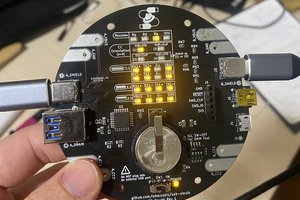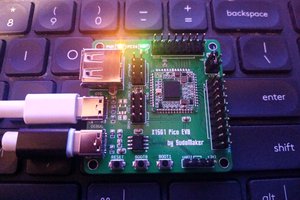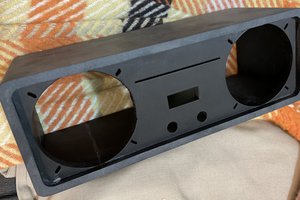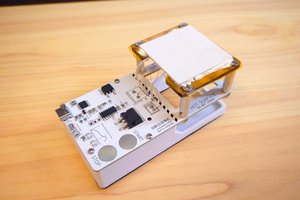If you want to dig deeper, you can modify your Workbench Assistant's CircuitPython code. Code & files may be modified over the USB-C connector or you can put your files on an optional MicroSD card. The internal drive & the optional MicroSD card would appear as a pair of mass storage devices when the bot is connected to a computer.
The bot works by analyzing nearby temperatures & firing events when pre-defined patterns are identified. It will trigger other events -- such as turning on the lights -- when code & config allow it to. It uses a AMG8833 IR Thermal Camera, a Adafruit Itsy Bitsy M4 Express microcontroller featuring the Microchip ATSAMD51, a monaural amplifier & an enclosed speaker. It includes a high-velocity 40mm server fan & numerous bright RGBW light 'pixels'. The prototype is powered by a laptop power supply and a pair of MP1584EN buck converters; the production version will be powered by internal lithium ion batteries or via USB-C PD, which can easily provide the bot all the power it needs.
Key Features
These are features you should expect in production versions of the Workbench Assistant:
- Rugged construction
- Compact size
- Compatible with most tripods & camera mounts
- Available in various anodized aluminum colors
- Available in various rugged plastic colors
- Available with integrated rechargeable batteries & BMS
- Thermal event based lighting effects
- Thermal event based fume extractor fan speeds
- Thermal event based sound effects
- Auto-recalibration when background thermal readings change significantly
- Easy behavior changes without needing to mess with the CircuitPython code
- Able to operate via off-the-shelf USB-C devices, including battery packs
- Optional matching yolk if overhead mount is desired
- Optional 3 foot USB-C cable
- Optional 6 foot USB-C cable
- Optional USB-C AC power adapter
- Optional USB-C DC automotive power adapter
- Optional USB-C battery pack
About the Project
The Prototype
The Workbench Assistant prototype was thought of, designed, built & configured in less than three months in the spring & summer of 2019. It was hand-soldered on proto board with parts from various vendors on Amazon, metal from the local Ace hardware store & features three exceptional parts from Adafruit. The enclosure was quickly designed on some index cards, cut with shears & bent into shape without a metal brake. This was the first project I've worked on requiring a custom metal enclosure & I'm sure it won't be the last.
The Product Vision
The Workbench Assistant will feature all the functionality found in the prototype, but will of course consist of high-quality PCB(s) designed specifically for the device. The metal enclosure will be made of high-quality scratch-resistant laser-cut aluminum. Airflow optimizations are being actively pursued & convenient hardware expansion options will be considered. Variations of the product are expected but all will feature high-quality components & the same API. Suggestions are _more_ than welcome!
What's Next
* Post-prototype build analysis; user testing
* PCB design
* PCB pre-production tests & revisions
* CircuitPython code refactoring & feature additions (YAML support, etc)
* API beta release & related documentation
* CircuitPython code release & related documentation
* Pre-production QA
* First production run
* Deliver the first Workbench Assistant bots to eager pre-order customers
* and more...
The Early Design Process
The need for a fume extractor in this form factor was realized while working on another project I look forward to discussing soon. A few years ago I modified my standard overhead fume extractor to use a 12V PC fan instead of a 120VAC fan, and eventually added strips of 12V LED lights to turn it into a combo lighting & fume extraction fixture. Given how much soldering I do, I decided I wanted to automate the fixture somehow. After learning about the AMG8833, I realized it would be fairly easy to write software capable of detecting a human, a soldering iron or other...
Read more » William
William
 Spencer Maroukis
Spencer Maroukis
 Reimu NotMoe
Reimu NotMoe

 tobychui
tobychui
a2themes for nearly all its computing and storage needs, including databases, analytics, recommendation engines, video transcoding, and more—hundreds of functions that in total use more than 100,000 server instances on AWS.